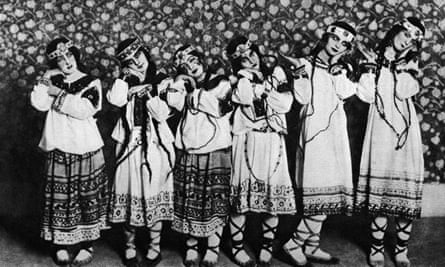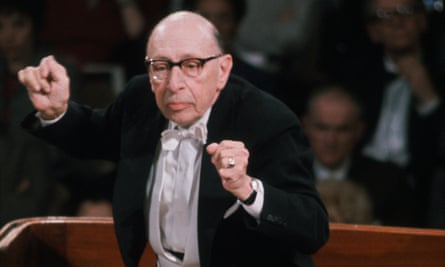Of the composers who spearheaded modernism in music at the beginning of the 20th century, it has been Igor Stravinsky (1882-1971) whose influence has proved the most enduring and pervasive. While Stravinsky’s own music radically changed direction twice during his 70-year career – so radically, in fact, that his works of each phase could easily have been written by different composers – without him 20th-century music could have followed a very different course.
The music you might recognise
For many, their first encounter with Stravinsky’s music is in Walt Disney’s celebrated 1940 animation Fantasia, in which his most famous work, The Rite of Spring, accompanies the longest sequence in the film, depicting the creation of the Earth, and the dinosaurs. Stravinsky reportedly hated the way in which Disney had used his music. More recently, musicians from Charlie Parker and Ornette Coleman to Joni Mitchell and the Pet Shop Boys have made references to the Rite particularly, while innumerable film scores – from Bernard Hermann’s for Psycho, Jerry Goldsmith’s for Planet of the Apes to John Williams’s for Jaws and Star Wars – owe it an audible debt.
His life ...
Stravinsky grew up in St Petersburg, Russia, where his father was a leading bass in the Imperial Opera. His parents discouraged him from a musical career, insisting instead that he study to be a lawyer at the university of St Petersburg. There he befriended Vladimir, the youngest son of the composer Nikolai Rimsky-Korsakov, and through him was able to arrange lessons with his father, which continued until the older composer’s death in 1908.
As well as a Chant Funèbre, a memorial to his teacher and only rediscovered recently, the works that Stravinsky wrote during this period included a Symphony in E flat. But it was two brilliantly coloured orchestral showpieces, Scherzo Fantastique and Fireworks, that caught the attention of the impresario Serge Diaghilev, who was seeking a Russian to compose a ballet on the legend of the Firebird for his Ballets Russes season in Paris. The Firebird was premiered in 1910 and was an immediate success.

By then Stravinsky had a wife and two children, and the family divided their time between France and Switzerland, where his second ballet score for Diaghilev, Petrushka, was written. First performed in 1911, it was not quite as well received as Firebird, but his third work for the Ballets Russes was The Rite of Spring, and its premiere in Paris in May 1913, was one of the most sensational in musical history, if never quite the riot that is sometimes claimed. The primitivism of the scenario, in which a young girl is chosen as a sacrificial victim and dances herself to death, was matched by the unprecedented violence of Stravinsky’s score, with its high levels of dissonance, irregular metre and ferocious rhythmic drive. The fairytale enchantment of The Firebird and the world of tsarist Russia had been left far behind.
And times …
The three great world-changing events of Stravinsky’s lifetime, the two world wars and the Russian revolution, all impinged directly on his career, determining where he made his home and the way his music developed. After the premiere of The Rite he briefly went back to Russia, where he began his first opera, The Nightingale, but after another brief visit in 1914 he did not return there for 48 years. The Stravinsky family spent the years of the first world war in Switzerland, where the limited opportunities for performances meant that large-scale orchestral works were out of the question. Stravinsky turned to small-scale music-drama, with Renard and The Soldier’s Tale, pieces that are now seen as forerunners of late 20th-century music theatre.
After the war, the Symphonies of Wind Instruments, a memorial to Debussy, proved to be one of his most remarkable achievements, with its mosaic-like construction, while another utterly original score, the ballet Les Noces (The Wedding) scored for soloists, chorus, four pianos and percussion, together with the one-act comic opera Mavra, was effectively a farewell to the world of Russian folk culture that had underpinned Stravinsky’s music for almost two decades.
Mavra was also one of the first works to reveal the remarkable stylistic change that came over his music in the 1920s. Once again Diaghilev provided the catalyst, suggesting Stravinsky compose a ballet to an 18th-century commedia dell’arte scenario, using the music of Giovanni Pergolesi as his starting point. The result was Pulcinella, in which Stravinsky borrowed baroque forms and themes; it was, he later said, “My discovery of the past, the epiphany through which the whole of my late work became possible.”

Between the wars, Stravinsky was based in France. As well as composing, he was building a career as a conductor of his music, and the works he produced continued to show the formal clarity and restraint of the neoclassical style that he had discovered with Pulcinella. There were more ballets – Apollo, The Fairy’s Kiss (based upon music by Tchaikovsky) and Jeu de Cartes, concertos for piano and violin, and one of his most popular middle-period works, the choral Symphony of Psalms (1930). And as his international fame increased, there were also collaborations with some of the most celebrated writers and artists of the time. Pablo Picasso, the dramatist and film-maker Jean Cocteau (on 1927 opera-oratorio Oedipus Rex), and writer André Gide among them.
Stravinsky moved to the United States in 1939. His first wife, Katya, had died earlier the same year, leaving him free to marry the dancer and artist Vera de Bosset, with whom he had been in a relationship since 1921. The couple settled in Los Angeles, where they found themselves part of an expatriate artistic community that included musicians and writers such as Otto Klemperer and Arthur Rubinstein, Thomas Mann and Aldous Huxley, while others – WH Auden and Dylan Thomas – visited him regularly there.
The major works of the early years in the US were two symphonies, the Symphony in C and the Symphony in Three Movements. He and Vera became US citizens in 1945, and Stravinsky set about re-establishing copyright in his work, reorchestrating a number of his major scores and signing a lucrative new publishing deal. A visit to an exhibition of prints by William Hogarth was the starting point for the culminating work of his neoclassical period, the opera The Rake’s Progress, first performed in Venice in 1951. Auden and Chester Kallman wrote a libretto based on Hogarth’s engravings, depicting the story of a young man tempted into debauchery and ruin, while Stravinsky modelled his score on the classical “number opera”, made up of a chain of set-piece arias interspersed with passages of recitatives.
After The Rake, Stravinsky’s music changed direction again. His music represented a separate strand of modernism from that of Arnold Schoenberg and the Second Viennese School, and though both composers lived in Beverly Hills, they avoided each other. But after Schoenberg’s death in 1951, Stravinsky began to explore the possibilities of the 12-note serial technique that Schoenberg had invented. By then, too, Stravinsky had acquired a musical assistant, the conductor Robert Craft, who would remain at the composer’s side until his death in 1971, and with whom he collaborated on a series of books of conversations.
With the exception perhaps of the 1957 ballet Agon, none of the spare, angular pieces from Stravinsky’s last two decades has achieved the popularity of his earlier music, but nevertheless works such as Canticum Sacrum, The Flood, and Threni remain fascinating examples of the way in which he was able to acquire a new compositional voice.
Why does Stravinsky still matter?
It’s hard to think of a significant composer from the last 100 years who has not been influenced by Stravinsky. The neoclassical aesthetic was picked up by several generations of composers on both sides of the Atlantic, while the 1950s avant-garde led by Pierre Boulez and Karlheinz Stockhausen hailed him for the way in which he had emancipated rhythm and metre. The pulsing textures at the foundation of minimalism would have been unthinkable without him, too; that British composers of recent times as utterly unalike as John Tavener and Harrison Birtwistle both declared their debt to Stravinsky shows just how pervasive his influence has been.
Great performers

In the 1950s and 60s, the composer himself conducted almost all his orchestral works for Columbia, recordings that have been repackaged several times in bargain boxes. But many conductors have put their own imprint on this repertoire, from Ernest Ansermet, who conducted a number of Stravinsky premieres including Les Noces and Pulcinella and recorded extensively for Decca, through Boulez, whose recordings for CBS/Sony and Deutsche Grammophon include all the early masterpieces, to Riccardo Chailly, whose Decca recordings include perhaps the finest of all versions of The Rake’s Progress. And Robert Craft also made a series of recordings for Naxos of the music of the composer he assisted for so long.

Comments (…)
Sign in or create your Guardian account to join the discussion